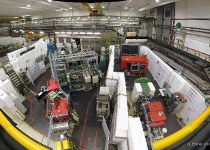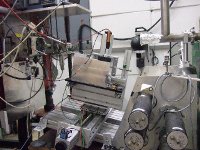 |
 |
|||||||||||||
|
|||||||||||||
|
|||||||||||||
|
What is a polarimeter?
A polarimeter measures the combined spins (polarisation) of particles in a particle bunch, by using the effect that photons from a laser beam can knock single electrons out of a particle bunch. These 'Compton-scattered' electrons are sent through a magnetic chicane where they are deflected. The degree of deflection depends on their energy which, in turn, depends on its own polarisation. Behind the chicane, the electrons are sent through gas-filled tubes with mirrors on the inside. Flying through the tubes, they emit a blue light – Cherenkov radiation – which is directed at the end of the tube by the inside mirror surface. A photo detector measures the amount of light that comes through. Read more about polarisation Most collaborations who test their detector prototypes in a test beam want a well-defined stream of single particles into their setup so that they can test their equipment, alignment and software in order to cross-check it against the particle beam. Others want their setup bombarded to see whether it works – for example, the team around DESY's Jenny List, who design and build so-called polarimeters that measure the combined spin of the beams of electrons and positrons as they pass through before and after they have collided. (Read the info box for a more detailed description of a polarimeter or follow the link to learn more about polarisation.) Their recently assembled first prototype and four different photo detectors have even more recently passed their test at 'ELSA', an electron accelerator (ELSA stands for Elektronen-Stretcher-Anlage or electron stretcher facility) in a basement of Bonn University in Germany which provides exactly the sort of beam that the team needed. The beam contains several hundred electrons, meaning more realistic conditions than in the DESY testbeam in which the team calibrated their prototype. Beams in the ILC will produce some 2000 Compton-scattered electrons per bunch crossing, several hundred per detector channel.
The prototype is not exactly what a real polarimeter detector would look like in the ILC tunnel, for example it has fewer channels. “This one is more of a physical rather than a technical prototype,” says List, “we want to check the physical principles and the detectors.” The team is now busy analysing its data. -- Barbara Warmbein |
|||||||||||||
| © International Linear Collider |

